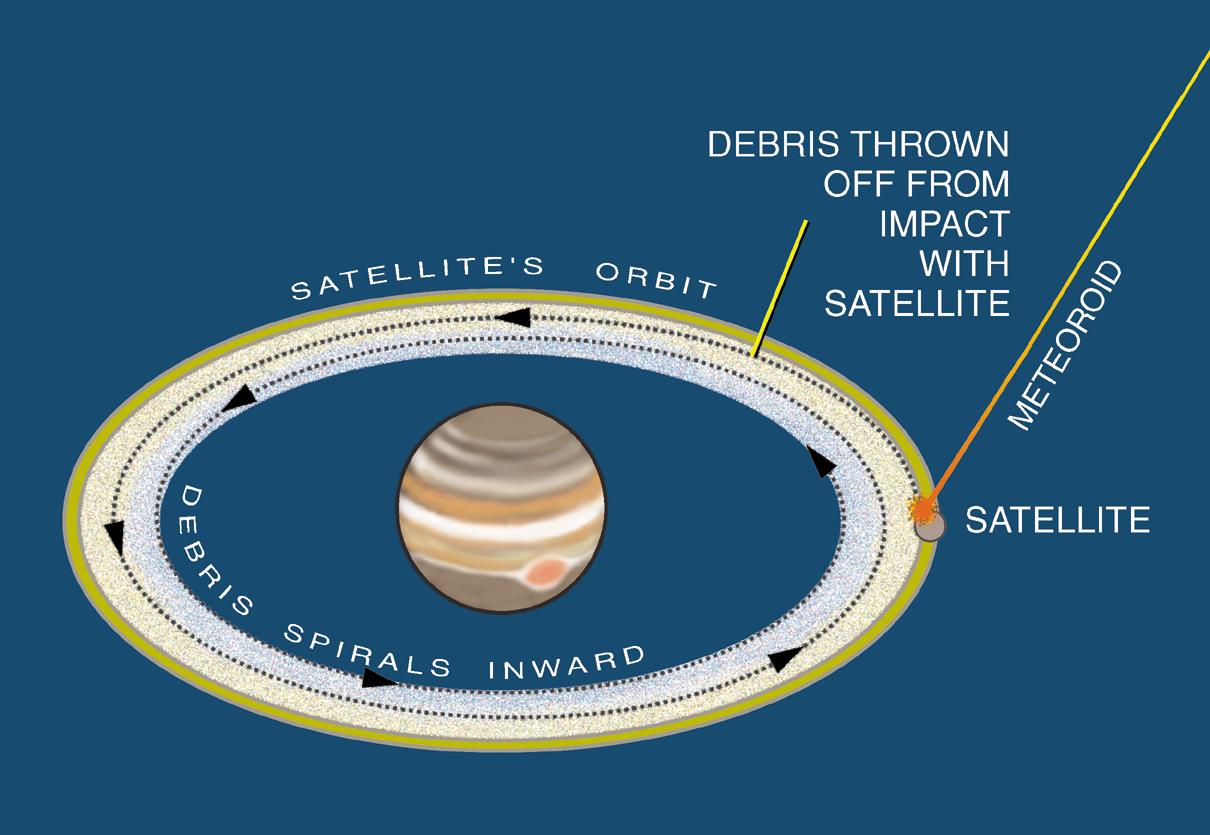-
The basic understanding
of the interiors of gas giants
is explicated in figure below
(local link /
general link: gas_giant_interior.html).
-
The atmospheres of the gas giants
are usually considered those upper levels where
the material can be considered
gas and where one finds clouds.
- Band Structure:
The most obvious common feature of the gas giant atmospheres is their band structure.
The atmospheres and band structure vary considerably among the gas giants.
We will just consider the case of Jupiter which is the best studied and has the most prominent gas giant bands.
Jupiter and its gas giant bands are shown in the figure below (local link / general link: jupiter_full_aurora.html).
The Jupiter bands change in a bit in color and brightness, but at least for Jupiter, they have been unchanging in position for as long we've been mapping them in detail (Se-499)---probably only since the advent of astrophotography in the mid 19th century.
To see some of the fine detail of the Jupiter bands, see video Juno Perijove 06 | 3:00 in Jupiter videos below (local link / general link: jupiter_videos.html):
- EOF
- What Are the Jupiter Bands?
What are the Jupiter bands?
They are the tops of rising and sinking convection cells organized as bands parallel to the Jovian equator.
-
Question: What physical condition must be essential in
imposing the band structure
of bands parallel to the Jovian equator?
- Jupiter's fast rotation.
- Jupiter's magnetic field.
- The solar wind.
Answer 1 is right. Rotation is what breaks the spherical symmetry.It is an essential ingredient to band structure.
But just saying "rotation" is NOT a full explanation. We won't give a full explanation of the Jupiter bands.
-
Earth has convection bands too. The ground-level
wind patterns associated with are:
- the tropical east trade winds---which blow mainly west.
- the mid-latitude Westerlies---which blow mainly east.
- and the polar easterlies---which blow mainly west.
Thus, six bands in all counting the northern and southern hemisphere mirror image versions separately.
But on Earth the bands are NOT nearly so stable and often they are invisible since they are often just moving clear air.
The Earth atmospheric circulation is shown in the figure below (local link / general link: hadley_cell.html).
Venus has two large bands, on in the northern hemisphere and one in the southern hemisphere, as we saw in IAL 13: Venus: Venusian Weather.
- The Driver of Convection on Jupiter and the Other Gas Giants:
The Jupiter bands must be rather different though than those of Earth and Venus.
For one thing, on Earth and Venus it is solar energy that drives the convection. On Jupiter and the other gas giant planet, their own primordial-radiogenic heat geology (see also Wikipedia: Earth's internal heat budget: Radiogenic heat: Primordial heat) is probably the main driver of convection.
Modeling and Galileo orbiter probe sent into the Jupiter atmosphere suggested that the Jupiter bands extend to great depth into the interior (Se-499).
But here we will just consider the surface as it is currently understood by looking at the cartoon in the figure below.
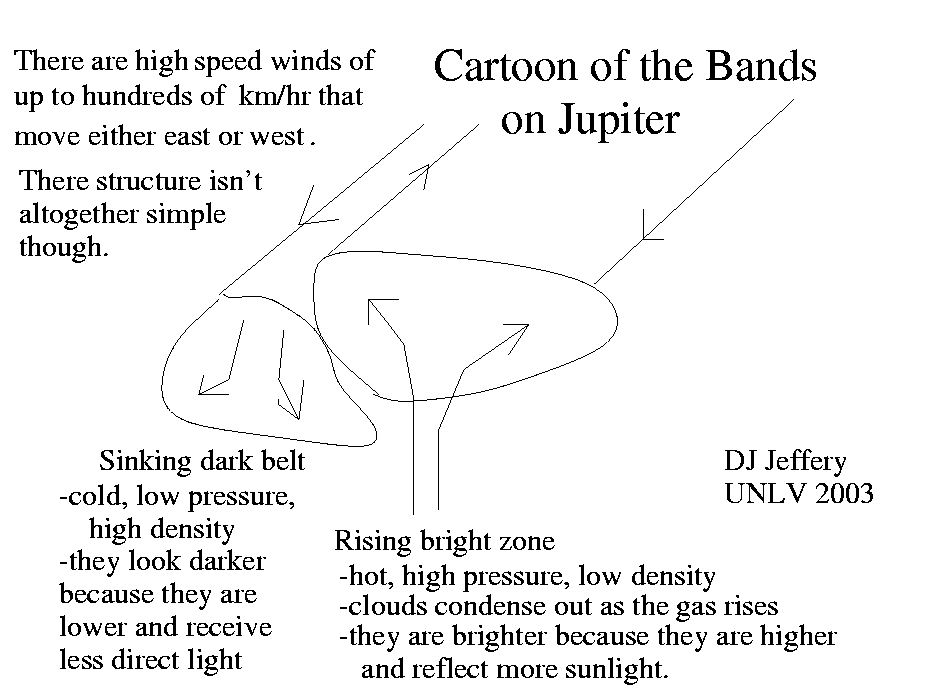
Caption: A cartoon of the Jupiter bands.
Credit/Permission: © David Jeffery, 2003 / Own work. Image link: Itself.
- The Cloud Layers:
The CLOUD LAYERS in the Jupiter bands are made of ice crystals of various kinds.
The upper layer is ammonia (NH_3), the next layer in is ammonia hydrosulfide, and the 3rd layer is water.
Spectroscopy tells us about the cloud material. But these crystals are all white.
Molecular hydrogen (H_2) gas and helium gas are colorless.
Thus, the COLORS the Jupiter bands are thought to be due to trace amounts of sulfur and/or phosphorus in compounds (Se-499).
At the top of the clouds the temperature is about 150 K. At the bottom about 300 K.
As one goes inward it gets hotter. The internal heat of Jupiter accounts for that.
There are high speed east and west winds of hundreds of kilometers per hour in the Jupiter bands, but actual measurements don't show a simple pattern (FMW-220).
The high speeds are probably partly due to the Coriolis force which causes the main band winds on Earth. But probably are also due to deep circular motions (Se-499).
The Coriolis force on Earth and other planets is explicated in the figure below (local link / general link: coriolis_force.html).
But it's considered a powerful rotating storm---it is a Jovian vortex.
The rotation period of the is about 6 days (FMW-221).
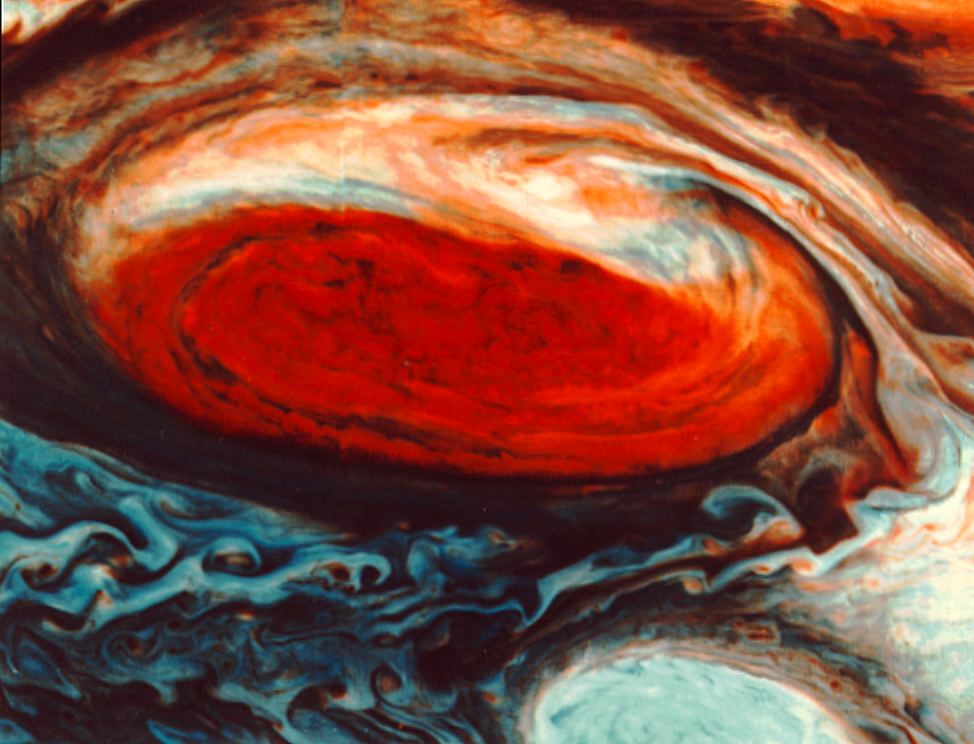
Caption: Jupiter's Great Red Spot in false color from Voyager 1, 1979jun06.
North is at the top and bottom to top is 24,000 km.
The colors enhance reds and blues and suppress greens.
As one can see, a complicated turbulent flow around the big vortex.
See the official caption for more information.
Credit/Permission: NASA, Voyager 1 (1977--c.2025), 1979 / Public domain.
Download site: NASA: NSSDCA Photo Gallery.
Image link: Itself.
- What Are the Jupiter Bands?
We can only have a brief look the atmospheres.
-
Group Activity:
Form groups of 2 or 3---NOT more---and tackle Homework 15 problems 2--7 on the gas giant planets.
Discuss each problem and come to a group answer.
Oh, 5--10 minutes.
See Solutions 15.
The winners get chocolates.
-
The gas giants have altogether
285 known moons in
2024.
(See Wikipedia: Jupiter's moons: 95 (2024),
Wikipedia: Saturn's moons: 146 (2024),
Wikipedia: Uranus's moons: 28 (2024),
and Wikipedia: Neptune's moons: 16 (2024).)
There will probably be a few new very small ones to be discovered, but we may have exhausted
all that are much larger than kilometer size scale.
- The Moons of Jupiter:
Jupiter has 95 known moons circa 2022 (See Wikipedia: Jupiter's moons: 95 (2024), Wikipedia: Saturn's moons: 146 (2024), Wikipedia: Uranus's moons: 28 (2024), and Wikipedia: Neptune's moons: 16 (2024).)
Most of Jupiter's moons are very small and all the large ones were found long ago.
All Jupiter's moons are unique and have interesting features---but maybe NOT that interesting.
The Galilean moons are by far the largest of Jupiter's moons.
- Galilean Moons:
The 4 Galilean moons discovered by Galileo (1564--1642) in 1610 (HI-214).
-
Recall that we briefly looked at
Jupiter's has 4 small
moons that are within the orbital radius of the
innermost Galilean moon
Io
(see subsection
Formation of the Moons of the Gas Giants).
They are Metis,
Adrastea,
Amalthea,
and Thebe.
See file
jupiter_inner_moons.html
for these 4 small
moons.
The Galilean moons are shown in two collage figures below (local link / general link: jupiter_galilean_moons_collage.html; local link / general link: jupiter_galilean_moons_collage_far.html).
We can first look that this range of behavior below in Table: Galilean Moon Orbital Facts.
___________________________________________________________________________ Table: Galilean Moon Orbital Facts ___________________________________________________________________________ Quantity Io Europa Ganymede Callisto ___________________________________________________________________________ Mean distance 5.903 9.386 14.967 26.339 from Jupiter (Jupiter equatorial radii) Orbital period 1.769 3.551 7.155 16.689 (days) The Galilean moons are all tidally locked to Jupiter: i.e., they always turn one side to Jupiter and their orbital periods and rotational periods are continually driven toward exact equality by the tidal force. The orbits of of Io, Europa, and Ganymede are in a 1:2:4 Laplace resonance. ___________________________________________________________________________
References: Cox-303--307, HI-213ff, Wikipedia: Galilean moons.
___________________________________________________________________________
The 3 innermost Galilean moons exhibit a 1:2:4 Laplace resonance as illustrated in the animation in the figure below (local link / general link: jupiter_galilean_moons_resonance.html).
- The Galilean Moon Size Facts:
See below Table: Galilean Moon Size Facts.
___________________________________________________________________________ Table: Galilean Moon Size Facts ___________________________________________________________________________ Quantity Io Europa Ganymede Callisto ___________________________________________________________________________ Equatorial radius 1820. 1565. 2634. 2403. (km) Io is rather asymmetric: 1820 km is a rough average. The Galilean moons are all among the 10 largest rocky/ice bodies in the solar system: in order one has Earth, Venus, Mars, Ganymede, Titan (the larget moon of Saturn), Mercury, Callisto, Io, the Moon, Europa. ___________________________________________________________________________
References: Cox-303--307, HI-213ff, Wikipedia: Galilean moons.
___________________________________________________________________________
The figure below (local link / general link: rocky_icy_body.html) shows how the Galilean moons rank in size among the Solar System rocky bodies and rocky-icy bodies.
From the figure below (local link / general link: moons_interesting.html), we can see that the Galilean moons among the moons of the Solar System have 1st, 3rd, 4th, and 6th largest sizes.
In fact, only the Moon (5th largest) and Titan (2nd largest) break up the dominance in size of the Galilean moons.
- Other Galilean Moon Facts:
See below Table: Other Galilean Moon Facts.
___________________________________________________________________________ Table: Other Galilean Moon Facts ___________________________________________________________________________ Quantity Io Europa Ganymede Callisto ___________________________________________________________________________ Mean Density 3.55 2.970 1.900 1.790 (g/cm**3) Composition silicates water ice water ice water ice sulfur carbonaceous carbonaceous carbonaceous metals silicates silicates silicates metals metals metals Note, in the outer system water ice and other ices (e.g., of CO_2 and CH_4) could condense out of the solar system and become primary planet building materials. So could carbon in the form of graphite and other black sooty compounds which we just label collectively as carbonaceous. Ices and carbonaceous compounds tend to cover the surfaces. Old surfaces are black because because a small amount of carbonaceous material give ices that color or because the ice has been vaporized by micrometeoritic impacts. Silicates and metals probably mostly chemically differentiated and sank to form cores: an inner one of iron and an outer one of silicates. On Io all the volatiles have evaporated and escape due to Io's intense tidal heat geology. Thus, sulfur is left as the abundant surface material. The mean densities tell us that Ganymede and Callisto have a large fraction of water ice. Recall water ice density is almost exactly 1 g/cm**3. Tidal heat extreme significant low low geology The Galilean moons have slightly eccentric orbits. This means that Jupiter's tidal force will continuously flex them. Internal friction leads to heating that can drive geology. The closer to Jupiter, the greater the tidal force and greater the tidal heating. The heat energy must ultimately come the rotational kinetic energy of the system, but exactly where is probably a tricky question. ___________________________________________________________________________
References: Cox-303--307, HI-213ff, Wikipedia: Galilean moons.___________________________________________________________________________
- Focus on Io, Europa, and Callisto:
Now let's focus on Io, Europa, and Callisto since they present interesting contrasting cases.
Ganymede is sort of intermediate in character between Callisto and Europa, and so doesn't make such an interesting contrasting case.
But even though we neglect poor old Ganymede as less interesting, it is still the largest moon and the 4th largest rocky-icy body in the Solar System.
- Io:
In the figure below (local link / general link: jupiter_io_full.html), behold Io.
Whenever an image is taken of Io, there is always one or more volcanic eruptions in progress---as the images and videos illustrate in the figure below (local link / general link: io_003_eruption.html).
- Europa:
And then there is Europa as seen in the image and videos in the figure below.
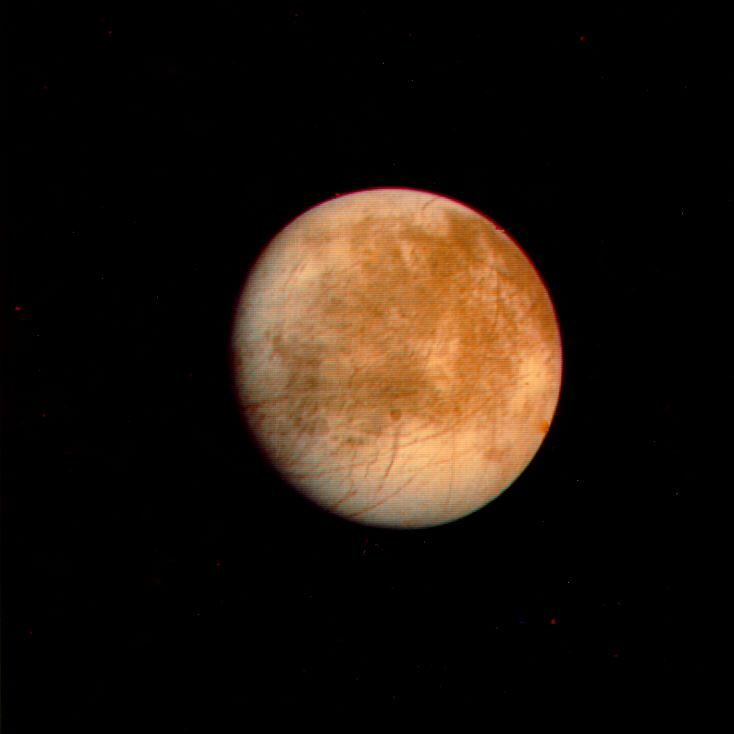
Caption: Europa: the 2nd innermost Galilean moon of Jupiter. Image from Voyager 1, 1979 Mar04.
This is a 3-color filter image, that may be close to true color: i.e., an orangy, off-white (SRJ-218, HI-217).
From a distance the surface of Europa looks bland except for the crinkly fractures that extend up to of order 3000 km and are about 100 km wide. The fractures are only of order 100 m deep.
The variation in height is small on Europa which gives it a smooth appearance.
But looked at closely there are all kinds of fine features which we won't consider in detail here.
Europa probably chemically differentiated. There may be an iron core and rocky mantle. On the surface is an icy layer that may be of order 100 km thick (HI-217).
The comparatively bland surface has few impact craters and is probably less than a few hundred million years old.
This implies resurfacing is ongoing today.
Perhaps the fractures are due due to flexing by the tidal force of Jupiter. But the Galileo spacecraft (1989--1995-arrival--2003) saw no fracturing during its time in orbit around Jupiter, and so the time scale must be longer than a few years.
When the fracturing occurs, the surface stretches and cracks and liquid water from below wells up and then freezes on the surface.
On the other hand or in addition, there may be ice volcanoes that break up the surface with "lava" flows of water.
In any case, over time there is resurfacing.
Note, liquid water from below is needed in this scenario.
Tidal flexing of the interior must be heating Europa inside to cause liquid water.
But the heating must significantly less than in the case of Io. This is understandable Io is closer in to Jupiter where the tidal force is stronger.
There may be an ocean of liquid water 10 km or more in thickness below the icy surface.
If liquid water exists, then there is a possibility of life as we know it. This is a very exciting prospect.
On the other hand, the liquid water may be far too acidic for life as we know it as we know. Circa 2004 someone??? proposed that Europa water is full of stuff like sulfuric acid (H_2SO_4) from sub-surface volcanism.
There is still a great deal of uncertainty about Europa's structure and evolution.
For more information on Europa, see HI-216, SRJ-218, Se-506, and Cox-303--307.
See also the video Europa: Ocean World | 4:12 in Jupiter videos below (local link / general link: jupiter_videos.html):
EOF
Credit/Permission: NASA, 1979 / Public domain.
Download site: NASA: NSSDC Photo Gallery Europa.
Image link: Itself.
- Callisto:
We skip merrily over Ganymede---the largest moon in the Solar System, but just so boring---and arrive at the last and least Galilean moon, Callisto.
See Callisto in the figure below.
So much for Callisto and the Galilean moons.
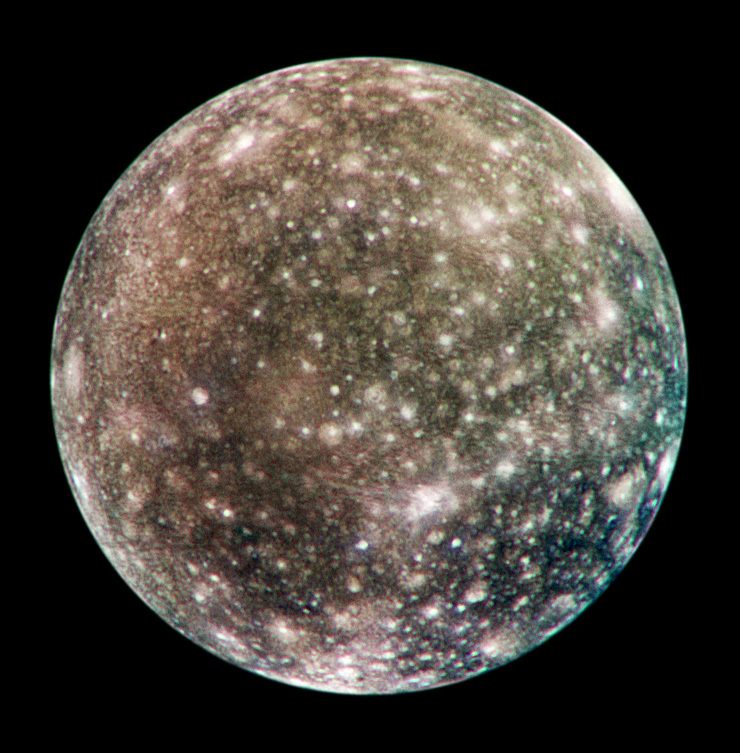
Caption: Callisto the outermost Galilean moon of Jupiter. A true color image from the Galileo spacecraft (1989--1995-arrival--2003), 2001 May.
Callisto's mean orbital radius is 26.34 Jupiter equatorial radii and its orbital period is 16.6890184 days.Callisto is probably about half water ice and half silicates. There is probably a rocky/iron core, a rock/ice mantle, and an ice crust???.
Micrometeoroid impacts have probably largely vaporized the surface water ice leaving a superficial layer of carbonaceous regolith.
Bright spots are relatively recent impact crater that have exposed underlying water ice.
Crater counts (including old dark ones) suggest that Callisto's surface has NOT been renewed since about 4 Gyr. Thus, there is probably little internal-heat geology.
But Callisto does have a weak magnetic field. It has been suggested that there is a dynamo effect due a subsurface of ocean of liquid water in which electrical currents flow due to ions in the water.
For more information, see HI-220 and Cox-303--307.
Credit/Permission: NASA, 2001 / Public domain.
Download site: NASA: Color global image of Jupiter's satellite Callisto.
Image link: Itself.
- Galilean Moons:
The new ones have evaded previous detection because they are all very small and inconspicuous. Someday, we will exhaust the population of objects large enough to be called moons, but that day may be far off and someone will have define how large astro-body has to be to be a moon. One can keep finding planet-orbiting astro-bodies until we are at the level of interplanetary dust.
Maybe there are a huge number of meteoroid-size-scale (10-meter-size-scale) moons, but are they moons?
We can't do everything re moons of the gas giants, so we will just consider the Galilean moons of Jupiter to save us from exhaustion.
-
Group Activity:
Form groups of 2 or 3---NOT more---and tackle Homework 15 problems 20--26 on the Galilean moons.
Discuss each problem and come to a group answer.
Oh, 5--10 minutes.
See Solutions 15.
The winners get chocolates.
-
All the gas giants
have planetary rings,
but only Saturn has conspicuous
planetary rings.
-
The Early History of Rings:
Galileo (1564--1642) in 1610 observed that Saturn seemed to have protuberances, but he couldn't make out their real shape (No-335).
A few years later they seemed to vanish and Galileo wondered "Does Saturn devour his children?"---an allusion to the Greek god Cronus---who was identified with the much more benign Roman god Saturn---who was a prototype for Santa Claus.
Christiaan Huygens (1629--1695) by 1656 had concluded that the Saturn's features constituted a thin ring and that its disappearance twice every Saturnian year was a consequence of seeing the ring edge-on (No-344).
The figure below (local link / general link: saturn_rings_orientation_perspective.html) illustrates the variation in the orientation of Saturn's rings as seen from the perspective of the Earth.
- More Rings:
As the centuries rolled by, more than one ring was identified for Saturn.
Going outward, one has the well known C ring, B ring, Cassini division (a gap region), and the A ring (Se-513). See the figure below.
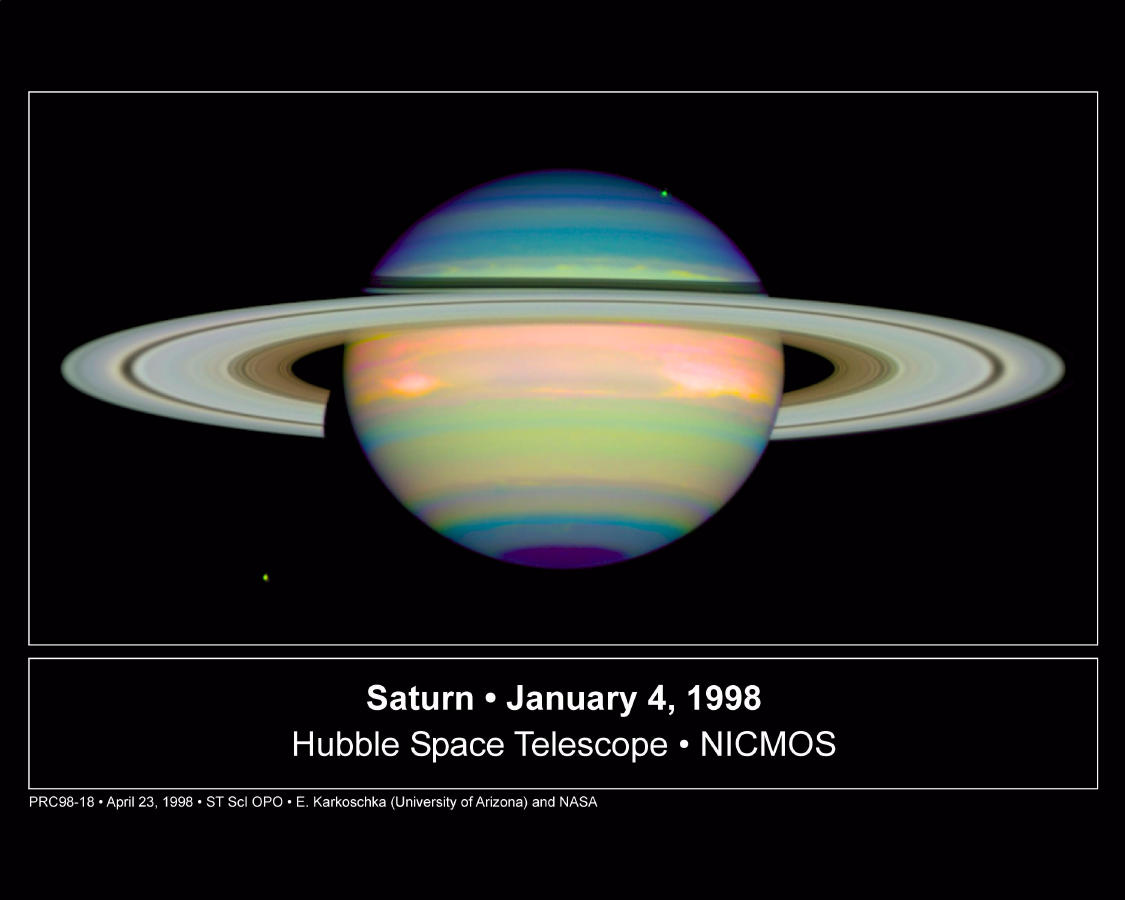
Caption: Saturn from the HST, 1998jan04.
This is a false color image showing infrared light reflection of Saturn.
The A and B rings are board and greyish and separated by the Cassini division (or gap): the A ring is on the outside.
The Cassini division is empty of large particles, but probably contains small dust grains similar to those that make up Jupiter's rings (HI-209).
The brown ring inside the B ring is the C ring.
Credit/Permission: NASA, HST, 1998 / Public domain.
Download site: NASA/HST: Alas, a dead link.
Image link: Itself.
The Voyager 1 and Voyager 2 showed showed that there are 10 rings at least and the rings themselves have intricate structures (Cox-311). For the intricacy of Saturn's rings, see the figure below (local link / general link: saturn_rings_false_color.html).
- Dark Rings:
Rings around Uranus had been suspected before Voyagers 1 and 2---which found DARK RINGS around Jupiter, Uranus, and Neptune.
Because those rings are dark and reflect very little light, they arn't easy to see from the Earth.
The VOYAGERS observed them best (and maybe only) when they (i.e., the VOYAGERS) were eclipsed by the planet. Then the faint reflection was NOT overwhelmed by contrast with brighter sources: i.e., the Sun and the planet itself reflecting sunlight.
Perhaps, the rings could also be seen as diminished sunlight when the VOYAGERS looked back at the Sun through the rings (HI-209)????.
- More Rings:
-
What and why?
- Planetary Rings in General:
In 1859, James Clerk Maxwell (1831--1879) showed that the Saturn's rings could NOT be solid disks.
They are so close to Saturn that Saturn's tidal force would tear a solid disk apart, unless the solid disks were made of some super-strong material.
The tidal force recall is the actually the difference in gravitational force between two parts of an object.
In general it will try to pull the object apart.
The tidal force difference gets bigger for larger objects and also the closer you get to a strong source of gravitation. This is illustrated in the figure below.
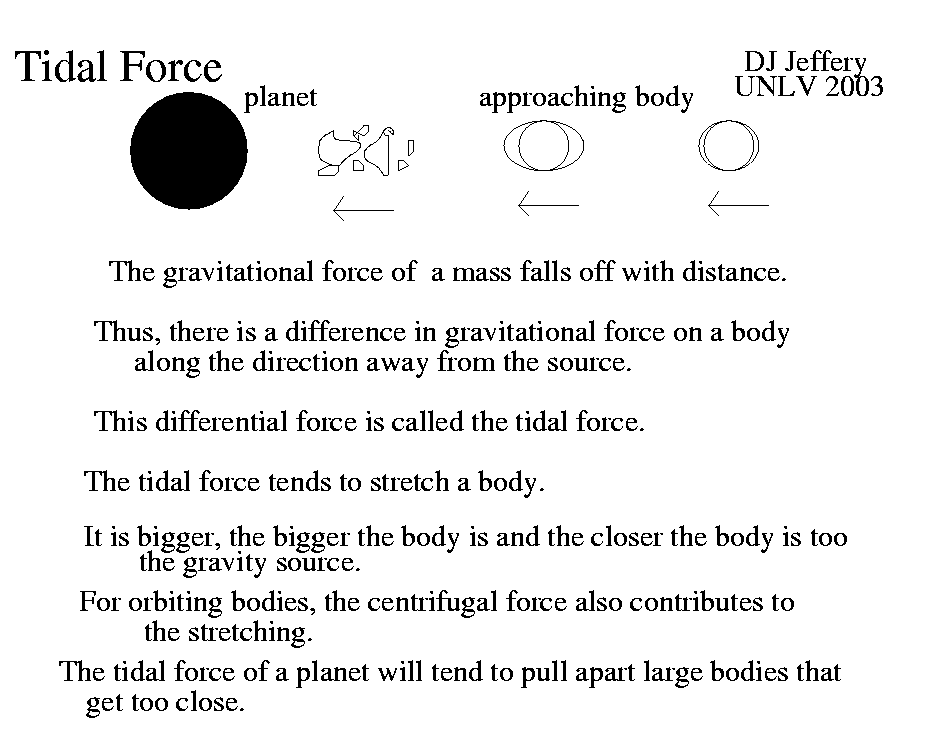
Caption: A cartoon of the tidal force pulling a body apart. (Correct "too" to "to" when you are able to.)
Credit/Permission: © David Jeffery, 2003 / Own work. Image link: Itself.
The Moon is safe at 60 Earth radii recall. It is stretched along the Earth-Moon line a little by the tidal force but doesn't pull apart.
-
Question: What would happen to the bits of an orbiting
object broken up by the tidal force?
- They would fall into the planet.
- They would escape from the gravitational field of the planet.
- They would just carry on orbiting the planet for the most part.
Answer 3 is right.The bits altogether still have much the same "sideways" kinetic energy (i.e., angular momentum) for orbiting that they had when they were stuck together.
So the bits would go into individual orbits around the gravitational source.
The individual orbits would have slightly different periods and speeds depending on orbital distance: longer periods and lower speeds the greater the distance.
The bits would NOT recoalesce under their mutual gravitational force because the tidal force cancels that effect.
But the rings are so close to the gas giants that the tidal force prevents them from coalescing into new moons.
Actually sufficiently small moons can co-exist with rings and are necessary for the existence of the non-Saturnian rings: recall the size of the tidal force depends on the size of the object: small enough objects arn't torn apart.
Planetary rings that are dark rings are explicated in the figure below.
- The main ring is the most visible of ring of the system.
The gossamer rings and thick halo are very transparent.
- The rings are probably made of dark rocky dust that is
knocked off Jupiter's inner minor
moons by meteoritic impacts.
The dust grains may have size scale of order 10 microns (SRJ-227).
- The small
moons
Adrastea, Metis,
Thebe, and Amalthea are
all closer to Jupiter than the closest large moon Io.
- Jupiter's tidal force keeps the dust from coalescing into
clumps under the dust's own gravity or falling back onto the moons.
- Image Caption 2: How the dark rings
form is explicated in the figure below.
- The ring material is actually believed to be spiralling into
Jupiter and must be continuously replenished
(HI-210).
Some perturbations must account for the in-spiral.
- The rings of Uranus and Neptune and Cassini's division
about Saturn are believed to also be rings of
the same nature as Jupiter's rings
(HI-209,232-234).
- Credit/Permission: NASA,
before or circa 2005 /
Public domain.
Download site: NASA: PIA01627.html Alas, a dead link.
Image link: Itself, - Credit/Permission: NASA,
before or circa 2005 /
Public domain.
Download site: NASA: PIA01627.html Alas, a dead link.
Image link: Itself.
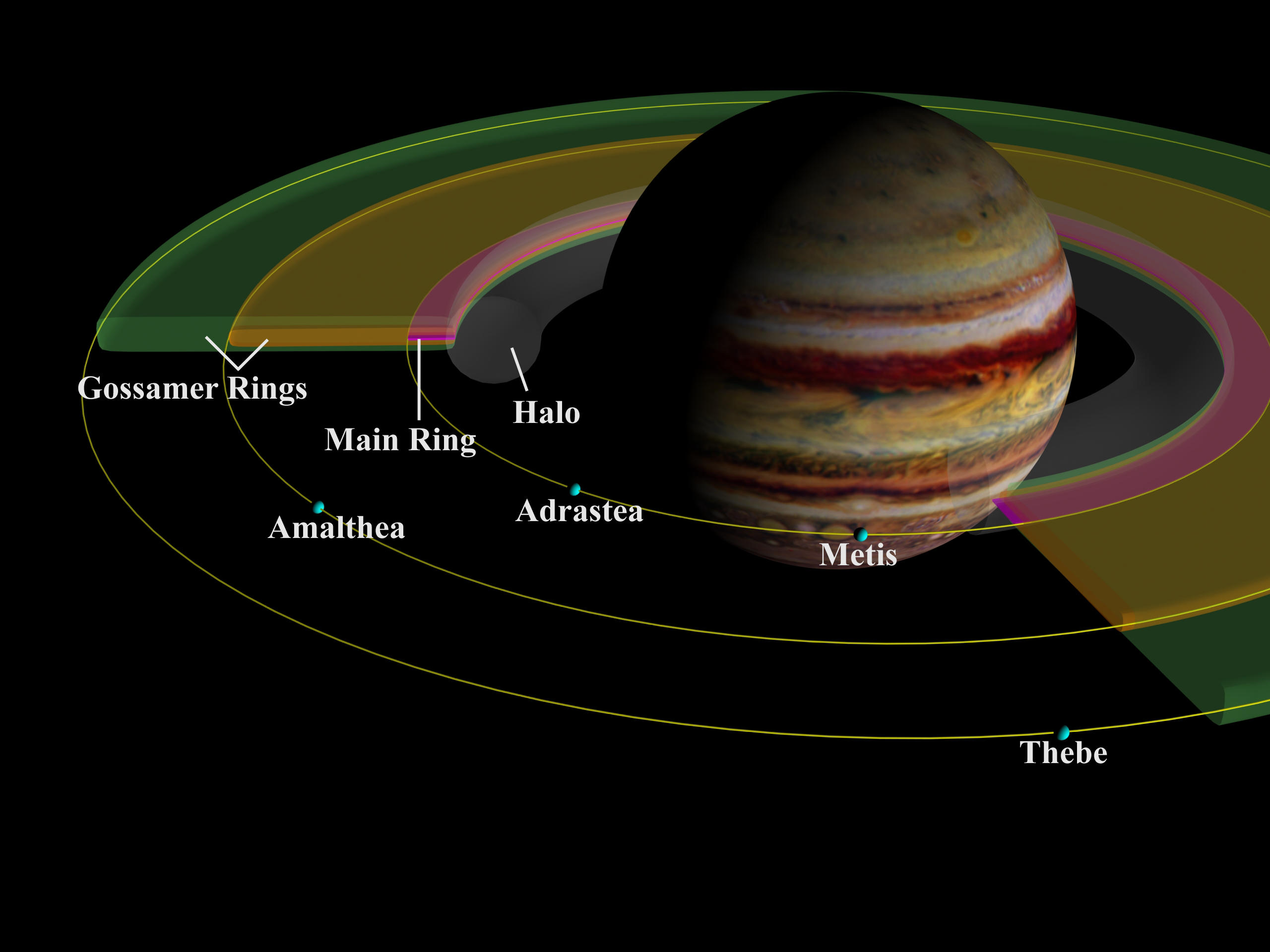
Image 1 Caption: A diagram of Jupiter's ring system.
Features:
-
Images:
More images of Jupiter's rings are shown in the figure below.
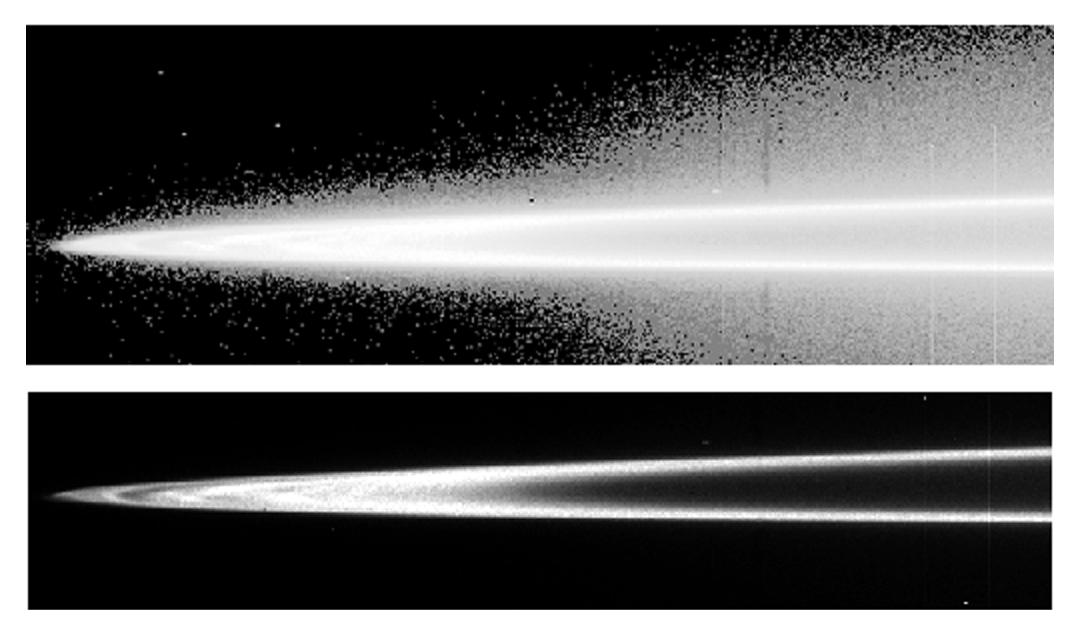
Caption: A Galileo mosaic of Jupiter's main ring and halo in two panels.
The two panels use different lighting scales so that the top one brings out the halo.
The image was taken under dark conditions when Galileo was eclipsed by Jupiter. This is necessary since the rings are dark and reflect very little light.
Rings are usually very flat.
The halo is vertically extended because electromagnetic forces acting on the charges on the ring particles keep the particles pushed out of the plane.
Because of its strong magnetic field and complex flows of ions from the solar wind and outgassing from Io, Jupiter has a pretty complicated electromagnetic environment.
Credit/Permission: NASA, before or circa 2005 / Public domain.
Download site: NASA: PIA01622.html. Alas, a dead link.
Image link: Itself.
-
Question: Why are rings usually flat?
- The tidal force overcomes
self-gravity to prevent the
particles from coalescing into a moon, but self-gravity
can still pull the particles into a thin disk since the
tidal force doesn't oppose that.
- Recall that the particles must orbit the center of mass
of Jupiter. Thus, if they arn't orbiting in single plane
they will tend to collide at high speeds.
The collisions will tend to cancel the opposing momenta between the particles, and thus on average cause them to leave the collision going more in the same direction than when the entered. (The particles don't just reverse their opposing momenta because some kinetic energy is lost to heat energy on collision. The lost kinetic energy also causes a spiraling in toward the planet.)
This complex process will continue until they the particles are orbiting in thin disk in which collisions are minimized.
You could call this a flattening process collisional relaxation to a disk.
Both right?Well one authoritative reference gives the 2nd answer, and so it must be the main reason.
But I think the 1st answer must play a role too. The individual particles have very small gravity, but there is a collective gravitational effect of all the particles on each one.
Actually both effects??? are used to explain the formation of protoplanetary disks. But protoplanetary disks are a bit different. They are much more massive and initially consist of gas that doesn't undergo simple collisions like particles.
Well rings end up orbiting on the EQUATORIAL PLANE of the planet. This is because of the planet oblateness.
The gravity field of an non-spherical body is NOT spherically symmetric.
The gravity of oblate bodies ends up favoring relaxation of the particles to a disk in the EQUATORIAL PLANE of the planet. See another authoritative reference.
-
Also the dust particles that make the rings came off small
moons
that may be orbiting equatorially or relatively close to equatorially???.
So a lot of perturbation to get the ring particles into equatorial orbits may NOT be necessary.
The small moons themselves probably were probably gravitationally perturbed into equatorial orbits.
Probably weak gravitational perturbations from the moons and planet and particle-particle collisions keep churning the particles up to a small degree and keep their orbits from perfectly aligning????.
- Saturn's Rings:
Now small dust particles account for the non-Saturnian rings, but Saturn's rings are clearly different.
Saturn's rings are CHUNKS of water ice from billiard ball to house size that relatively clos to each other ompared to their size. (HI-209, Se-512). See the artist's conception in the figure below (local link / general link: saturn_rings_artist_conception.html).
The fact that they are ICE (plus some other stuff one guesses) makes them highly reflective and thus very visible from Earth.
Saturn's rings at their densest would allow an astronaut to swim through them by pushing him/herself from particle to particle (Se-515).
The origin of Saturn's rings is NOT known definitively.
A plausible scenario is that within the last hundreds of millions of years, an impactor shattered an ICY MOON of Saturn and the rings are the debris (HI-212).
Thus, Saturn's rings are likely unusual and temporary and the non-Saturnian rings are likely to be normal.
-
The short answer is the subtle gravitational interactions of the many
moons, particularly small ones,
that mingle with the rings.
Also the tidal forces of the planets probably cause complications too.
To conclude the story, we'll just look at a few figures below.
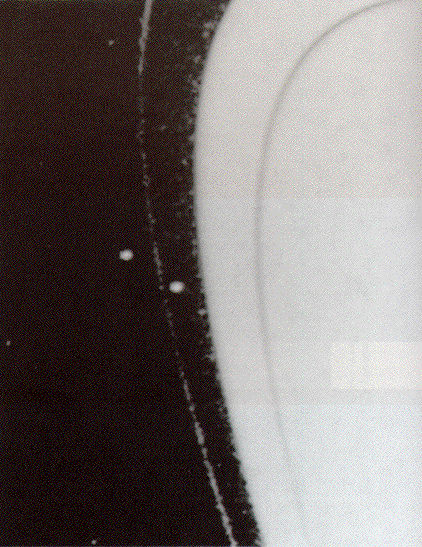
Caption: A Voyager 2 image of Saturn's F ring and moons Pandora and Prometheus.
The F ring is a very narrow ring with bends, kinks and bright clumps that give the illusion of a braided strand.
These unusual features are at least in part due to complex gravitational interactions with the small moons Pandora and Prometheus.
Such close, interacting moons have been called shepherd moons (SRJ-228).
Credit/Permission: NASA,
before or circa 2005 /
Public domain.
Download site: NASA:
saturn92.html.
Alas, a dead link.
Image link: Itself.
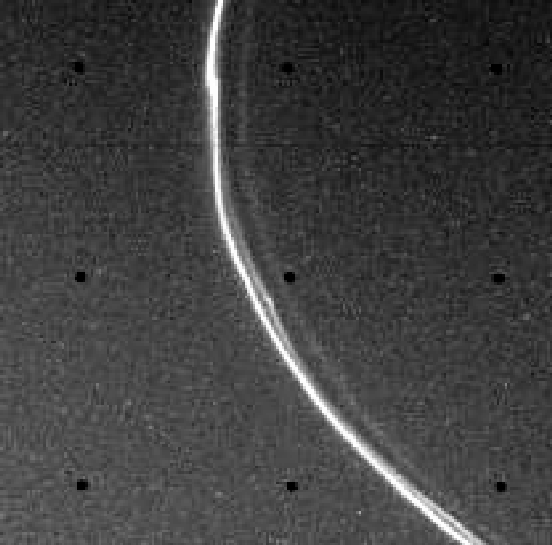
Capiton: A Voyager 1 image of Saturn's F ring.
The F ring is a very narrow ring with bends, kinks and bright clumps that give the illusion of a braided strand.
These unusual features are at least in part due to complex gravitational interactions with the small moons Pandora and Prometheus.
Such close, interacting moons have been called shepherd moons (SRJ-228).
Credit/Permission: NASA,
before or circa 2005 /
Public domain.
Download site: NASA:
c3493048.html.
Alas, a dead link.
Image link: Itself.
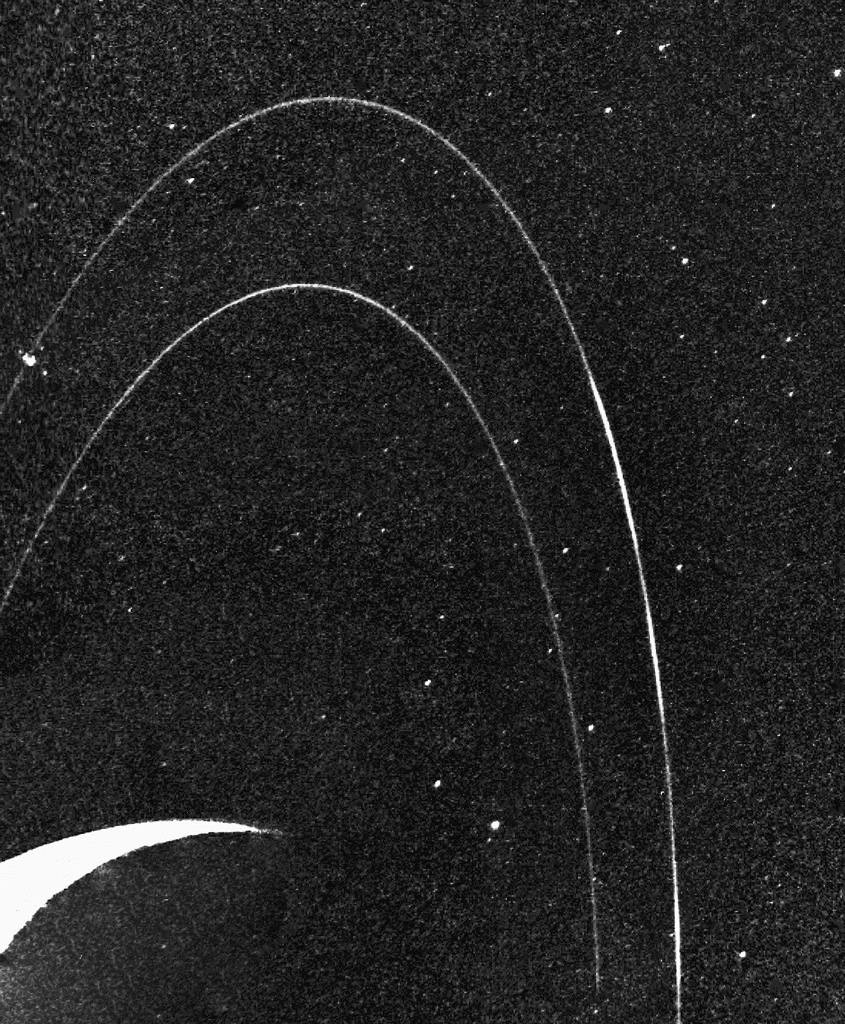
Capiton: Neptune and two of its narrow rings.
LeVerrier is the inner ring and Adams is the outer one.
LeVerrier is actually uniform in structure (although it doesn't quite look that way), but Adams shows concentrations of particles that turn up as bright arcs.
Adams has four arcs of which three are visible in this image: Liberte, Egalite, Fraternite.
The arcs are probably due to gravitational perturbations of the 150 km diameter moon Galatea (SRJ-229) which is NOT seen in this image.
Credit/Permission: NASA,
before or circa 2005 /
Public domain.
Download site: NASA:
c1141251.html.
Alas, a dead link.
Image link: Itself.
UNDER CONSTRUCTION BELOW
Under construction, but see Cassini videos below (local link / general link: saturn_videos.html):
-
The gas giants
will just cool off forever---nearly fovever.
The residual heat of formation will become exhausted and the heat from long-lived radioactive isotopes will decline as those radioactive isotopes decay away (see, e.g., radiogenic_heat.html). The gas giants will escape being vaporized by the post-main-sequence Sun and will continue to orbit white dwarf Sun (i.e., the white dwarf remnant of the Sun) for of order 10**6 gigayears, but in larger orbits since the white dwarf Sun will only be about half the mass of the current Sun (see Wikipedia: Sun: After core hydrogen exhaustion; Timeline of Solar System evolution).
On the time scale of 10**6 gigayears, gas giants and any other remaining Solar System objects will be ejected from the Solar System by passing stars. Such ejections are super rare events, but they will happen if there is enough time.
The gas giants will then be rogue planets.
Note, evolution of the observable universe to 10**6 gigayears is highly speculative since we are extrapolating well beyond the age of the observable universe = 13.797(23) Gyr (Planck 2018) since the Big Bang. For that past time frame we have a good theory the Λ-CDM model which even if it needs replacement CANNOT be wrong in rough outline---there is lots of evidence for it. But extrapolating the Λ-CDM model for even 10s of gigayears into the future is highly speculative. Many cosmic factors of which we know little or nothing can come into play. But for highly speculative extrapolation, see Wikipedia: Timeline of the far future, Wikipedia: Future of an expanding universe, Wikipedia: Graphical timeline from Big Bang to Heat Death (but note that the left-hand vertical scale is tricky: for > 10 years, it is x=100*log(log(t_year)), and so t_year=10**(10**(x/100)) ).
